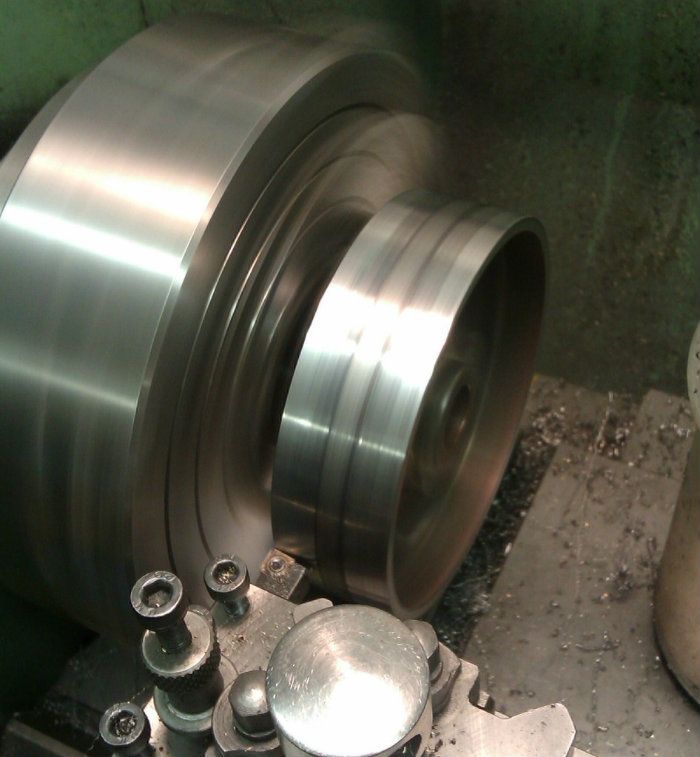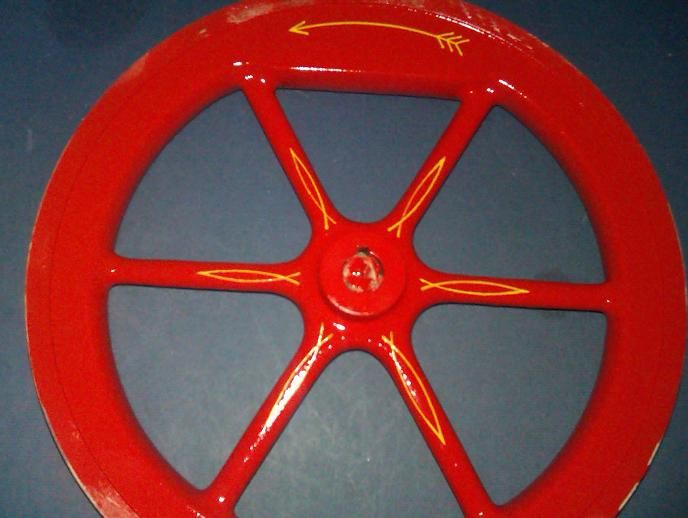How to machine a flywheel ?
Correct positioning on the face plate.
| Brian John | 18/06/2014 14:07:13 |
| 1487 forum posts 582 photos | Who sells 1/4 inch mandrels in the UK ? There are a few companies selling them in the US but their postage rates are exorbitant. |
| roy entwistle | 18/06/2014 15:54:45 |
| 1716 forum posts | Brian You've got a lathe and you're asking who sells mandrels Why ? Roy Edited By roy entwistle on 18/06/2014 15:55:38 |
| JasonB | 18/06/2014 16:47:00 |
25215 forum posts 3105 photos 1 articles | ARC do them but its an ideal little job making your own that will get you used to using the lathe and far cheaper too.
J |
| Ian S C | 19/06/2014 14:28:30 |
7468 forum posts 230 photos | We made our own at school metal work so we could machine the gear blank for the hand bench grinder we were making. Ian S C |
| Brian John | 06/07/2014 04:41:16 |
| 1487 forum posts 582 photos | On the castings I have , the flywheel has a gradual slope from the centre of the outside surface down to the sides. I think that this is called the ''crown'' ? Should this be retained when machining the flywheel ? Does it serve any purpose other than for appearance ? |
| roy entwistle | 06/07/2014 06:45:28 |
| 1716 forum posts | Brian It's to keep the leather belt on when driving machinery etc Roy |
| JasonB | 06/07/2014 07:07:45 |
25215 forum posts 3105 photos 1 articles | What you have on the raw casting is the draught angle from the pattern which is needed to allow it to be with drawn from the casting sand. Depending on the intended engine you can either machine it flat or put a crown on it, either way it will need to be machined to get it smooth and concentric to the bore. If the engine has a separate pully to take the drive or its say on a Cameron feed pump etc then the flywheel would have a flat surface and it would be painted. If on the otherhand the flywheel is on a traction engine, portable or some stationary engines then it would need to be crowned as Roy says to keep a drive belt running on the rim. This is actually a radiused surface not a slope. J |
| Brian John | 06/07/2014 09:41:59 |
| 1487 forum posts 582 photos | Is it tricky to machine the crown ? I do not really need it on my flywheels but it might be worth trying. |
| JasonB | 06/07/2014 10:25:02 |
25215 forum posts 3105 photos 1 articles | I thought that might be the next question As shown below from left to right 1. Turn the sides and face of the flywheel to clean them up 2. roughly divide the face of teh flywheel into 3 and then by setting teh topslide a degree or two either way turn a shallow taper on teh outer two segments 3. With care while the lathe is running use a file to blend in the areas where the tapers meet the central section, then finish with Emery cloth backed by a bit of flat wood. On larger flywheels and pullies you sometimes have to use 5 facets not three, you should just be able to see the changes in the metal surface where this pully had the 5 facets done
And the finish after filing and finishing
|
| Ian S C | 06/07/2014 12:55:44 |
7468 forum posts 230 photos | As well as flat and crowned flywheels, they may be made with rope grooves, like this. This is a Stuart Turner S9 Ian S C
|
| Brian John | 25/10/2014 05:08:22 |
| 1487 forum posts 582 photos | How do you find the exact centre of the hub on the flywheel in order to drill the hole for the axle ? Edited By Brian John on 25/10/2014 05:09:11 |
| JasonB | 25/10/2014 07:37:46 |
25215 forum posts 3105 photos 1 articles | Usual way is to set the casting up on the lathe either on a faceplate or using a chuck and adjust its position until yhe inside edge of the rim runs as true as you can get it. Once this is done a facing cut can be taken accross the edge of the hub and then a spotting or centre drill held in the tailstock chuck is used to start the hole, followed buy opening up the hole in stages with drills and finish by boring and or reaming. The outside is machined at the same setting so this ensures that the rim is running true to the bore. J |
| Ennech | 25/10/2014 10:45:54 |
153 forum posts 143 photos | There is a section on this page **LINK** showing a regular contributor to the forum machining a flywheel |
| Brian John | 18/12/2014 03:52:09 |
| 1487 forum posts 582 photos | Should flywheels be painted first prior to machining ? I have read a few articles where the machinist did it this way as it saves having to mask off areas you do not want painted . It sounds like an excellent idea but are there any disadvantages to this method ? Edited By Brian John on 18/12/2014 03:52:59 |
| JasonB | 18/12/2014 07:33:55 |
25215 forum posts 3105 photos 1 articles | As you often need to hold the flywheel by the spokes or inside the rim you run the risk of damaging the paint. I tend to just mask the outside face of the rim and the bore to keep the worst of the paint of any bare metal then when its dry mount the flywheel in a mandrel and just take any paint of the rim with some abrasive ( cover the lathe bed with a board) Finish turned flywheels masked for painting
Add the pinstriping
Cleaned up to 400g which gives the satin finish I prefer to a blingy polished one
Edited By JasonB on 18/12/2014 07:34:42 |
| Brian John | 18/12/2014 12:39:18 |
| 1487 forum posts 582 photos | Nicely done : how did you do the pinstriping ? |
| JasonB | 18/12/2014 12:53:39 |
25215 forum posts 3105 photos 1 articles | Mostly with just a ruling pen held against a suitable guide, in the case case of teh one above it was a french curve. For rings around the flywheel I use the same ruling pen but steady may hand on the lathe toolpost as I rotate the flywheel by hand You will probably have to thin the paint a little, the one above is Humbrol so just used their thinners. The one below was a gold acrylic so used some airbrush medium that I had.
|
| Brian John | 30/03/2015 07:39:21 |
| 1487 forum posts 582 photos | When drilling the hole for the axle, should I drill a small hole first and get progressively larger ? Or just go straight to the 6.2mm drill bit and later finish with a 1/4 inch reamer ? |
| JasonB | 30/03/2015 07:58:35 |
25215 forum posts 3105 photos 1 articles | The 6.2mm drill could cut oversize and as you will be using a small machine I would say Face end of hub so drill won't wander Spot drill (centre drill if you wish) Drill 5mm, preferably a stub drill Drill 6.2 Ream Given the choice and a suitable boring bar I would drill about 5.5mm and then bore it out to a nice fit on the shaft as the reamer may give a fractionally larger hole than the actual size of your shaft. Edited By JasonB on 30/03/2015 07:59:29 |
| duncan webster | 31/03/2015 15:46:24 |
| 5307 forum posts 83 photos | I just gripped it in the 4 jaw using external jaws, face, bore for crank. then bore a register into the rim and take a skim as far as you can on OD. Turn round and grip using register, clock to skimmed OD, turn OD and face other side. trying to do it off a mandrel is hard work, chatter and ringing as the rim is not well supported |
Please login to post a reply.
Want the latest issue of Model Engineer or Model Engineers' Workshop? Use our magazine locator links to find your nearest stockist!
Sign up to our newsletter and get a free digital issue.
You can unsubscribe at anytime. View our privacy policy at www.mortons.co.uk/privacy
- hemingway ball turner
04/07/2025 14:40:26 - *Oct 2023: FORUM MIGRATION TIMELINE*
05/10/2023 07:57:11 - Making ER11 collet chuck
05/10/2023 07:56:24 - What did you do today? 2023
05/10/2023 07:25:01 - Orrery
05/10/2023 06:00:41 - Wera hand-tools
05/10/2023 05:47:07 - New member
05/10/2023 04:40:11 - Problems with external pot on at1 vfd
05/10/2023 00:06:32 - Drain plug
04/10/2023 23:36:17 - digi phase converter for 10 machines.....
04/10/2023 23:13:48 - More Latest Posts...
- View All Topics
- Reeves** - Rebuilt Royal Scot by Martin Evans
by John Broughton
£300.00 - BRITANNIA 5" GAUGE James Perrier
by Jon Seabright 1
£2,500.00 - Drill Grinder - for restoration
by Nigel Graham 2
£0.00 - WARCO WM18 MILLING MACHINE
by Alex Chudley
£1,200.00 - MYFORD SUPER 7 LATHE
by Alex Chudley
£2,000.00 - More "For Sale" Ads...
- D1-3 backplate
by Michael Horley
Price Not Specified - fixed steady for a Colchester bantam mark1 800
by George Jervis
Price Not Specified - lbsc pansy
by JACK SIDEBOTHAM
Price Not Specified - Pratt Burnerd multifit chuck key.
by Tim Riome
Price Not Specified - BANDSAW BLADE WELDER
by HUGH
Price Not Specified - More "Wanted" Ads...
Do you want to contact the Model Engineer and Model Engineers' Workshop team?
You can contact us by phone, mail or email about the magazines including becoming a contributor, submitting reader's letters or making queries about articles. You can also get in touch about this website, advertising or other general issues.
Click THIS LINK for full contact details.
For subscription issues please see THIS LINK.
Model Engineer Magazine
- Percival Marshall
- M.E. History
- LittleLEC
- M.E. Clock
ME Workshop
- An Adcock
- & Shipley
- Horizontal
- Mill
Subscribe Now
- Great savings
- Delivered to your door
Pre-order your copy!
- Delivered to your doorstep!
- Free UK delivery!



















 Register
Register Log-in
Log-in


